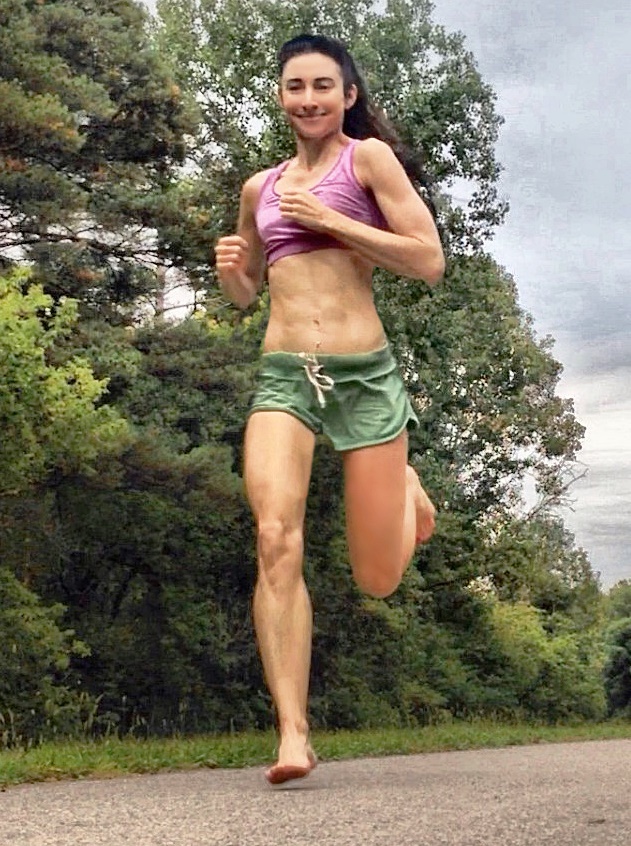Barefoot running is proven to do the most good in enabling you to run with near perfect form, which includes a proper forefoot strike landing, a shortened stride, a higher cadence, stronger dynamic balance, reduced ground-contact time and a more forward-leaning upper body posture. The net effect is significantly stronger feet, ankles and calves, less force-intensive footfalls, better foot step-stability, all of which shifts mechanical stress and impact loads away from the body. It’s for all these reasons many of the best coaches in the world, like Alberto Salazar, make barefoot running a big priority as part of their runners training regiment.


Barefoot Running Training Plan
Without further ado, here is a study-proven safe, sensible, easy barefoot running training plan that will help you ease into barefoot running without strife and can help you secure effective and efficient forefoot running mechanics for if you do prefer to run in shoes!
Week 1: Walk barefoot for 9 minutes + run barefoot for 1 minute on smooth pavement or on a track, NOT on grass (repeat this 3 times)
Week 2: Walk barefoot for 8 minutes + run barefoot for 2 minutes on smooth pavement or on a track, NOT on grass (repeat 3 times)
Week 3: Walk barefoot for 7 minutes + run barefoot for 3 minutes on smooth pavement or on a track, NOT on grass (repeat 3 times)
Week 4: Walk barefoot for 6 minutes + run barefoot for 4 minutes on smooth pavement or on a track (repeat 3 times)
Week 5: Walk barefoot for 5 minutes + run barefoot 3 minutes on smooth pavement or on a track (repeat 3 times)
Each week after this, keep reducing the barefoot walking time by 1 minute and increasing the barefoot running time by 1 minute on smooth pavement or a track.
As for barefoot running drills, I’ve found some recommendations from Pose Running and from Kenyan distance runners that will improve your mechanical effectiveness. Note that even though the demonstrators are wearing shoes, you’ll want to do the drills barefoot on smooth pavement or on a track to give you a powerful sense of your foot strike engagement as the ongoing sensory assistance will help you nail down a proper forefoot strike and will help keep your stride length within a safe range (prevents over-striding) as well as it instantly improves the withdrawal reflex of the leg, making you remove your foot off the ground faster and more responsively, so you end up developing a higher cadence and a shorter stride. Here’s the links to the drills https://www.youtube.com/watch?v=6Pv-qCjYgjM and https://www.youtube.com/watch?v=aR2MyqYs1pA — Try and do as many of these drills barefoot, if you can, if not, be sure to wear barefoot-like shoes. Do these drills down a 60 m-80 m stretch of smooth pavement or a track and repeat them 3x’s, twice a week. You can increase the number of intervals based on how you feel. However, always remember to listen to your body. If you feel pain, take time off until you feel 100%.
In regards to running barefoot and doing the above barefoot drills on pavement vs grass, I’ve done some videos about the important research showing that running barefoot on pavement may be more SAFE than on grass: https://www.youtube.com/playlist?list=PL9MUrbqsKH6c0V84_gU6FKc3EBOkYkEOy

Most essential, starting right NOW, your primary focus should be to walk barefoot as much as possible, especially on uneven surfaces because doing so keeps the feet functionally strong and capable of handling high mileage running. Most of the growth in your foots functional strength is going to come from the sensory input stimulating the bare underfoot. Not to mention, your toes now have the full participation in spreading, gripping, extending and flexing which is ultimately the best, most stable way to connect with the ground.
Aside from running barefoot, walking barefoot also increases the fat pad volume throughout the foot, affording you more layers of impact protection. Moreover, being barefoot also increases arch-height profile whereby a healthy arch-height profile is directly involved in delivering the type of energy from the feet that supports the economic strength that helps you go as many miles as you want to go with greater ease.
Last but not least, in case you do experience some pain problems in the shins or knees when you’re running barefoot, be sure to make the following adjustments to your biomechanics as they have proven to help correct mechanical imbalances:
Remember to lean slightly forward and avoid running too upright
Make initial ground-contact under the 5th and 4th toe, NOT on the big toe
Land lower on the balls of your feet, NOT super high up no your toes!
Keep your hands close to your heart and swing your arms towards the mid-line
If you’ve enjoyed my content, you’ll love the content over at my YouTube channel here where I go more in depth about the number of published studies showing the health and performance of benefits of barefoot running.
If you’d like, you can support Run Forefoot and help keep it going strong by making a donation in any amount of your choosing:

Bretta Riches
BSc Neurobiology; MSc Biomechanics candidate, ultra minimalist runner & founder of RunForefoot. I was a heel striker, always injured. I was inspired by the great Tirunesh Dibaba to try forefoot running. Now, I'm injury free. This is why I launched Run Forefoot, to advocate the health & performance benefits of forefoot running and to raise awareness on the dangers of heel striking, because the world needs to know.
Latest posts by Bretta Riches (see all)
- Forefoot Running and Achilles Pain - 19/04/2024
- Does Foot Strike Really Matter in Running? YES! - 17/04/2024
- Heel Lifts Increase Injury in Runners - 16/04/2024
